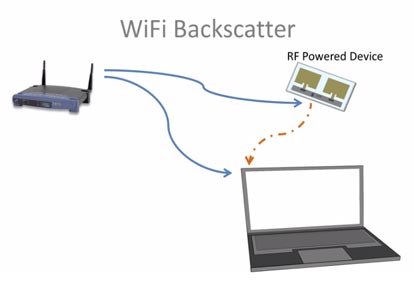Researchers at the University of Washington have developed a communication system that uses radio frequency signals and repurposes existing Wi-FI infrastructure to supply power and provide Internet connectivity, respectively, to battery-free devices.
Known as Wi-Fi backscatter, this technology is the first of its kind capable of connecting battery-free devices to Wi-Fi infrastructure, representing a significant step towards widespread adoption of the so-called “Internet of Things” concept. This proposed expansion of the Internet, also known as “Cloud of Things,” describes a reality in which sensors embedded in everyday objects are able to monitor and track everything from the structural safety of bridges to the health of a person’s heart. However, the lack of a cost-efficient way to power and connect these devices to the Internet has kept this concept from fully taking off—until now.
“If Internet of Things devices are going to take off, we must provide connectivity to the potentially billions of battery-free devices that will be embedded in everyday objects,” Shyam Gollakota, assistant professor of computer science and engineering at the University of Washington, explained. “We now have the ability to enable Wi-Fi connectivity for devices while consuming orders of magnitude less power than what Wi-Fi typically requires.”
According to a University of Washington press release, the new research builds upon earlier work on powering devices such as temperature sensors or wearable technology without batteries or cords by harnessing energy from existing radio, TV and wireless signals in the air. At the time, providing Wi-Fi connectivity to these devices wasn’t thought possible because conventional, low-power Wi-Fi consumes three to four orders of magnitude more power than can be harvested in these wireless signals.
As part of the latest work, researchers developed an ultra-low power tag prototype with an antenna and circuitry that searches for Wi-Fi signals traveling between the router and a laptop, smartphone or other Wi-Fi- enabled device. These tags encode data either by reflecting or not reflecting the Wi-Fi router’s signals, slightly altering the wireless signal. These minute changes, say the researchers, would be detected by the laptop or smartphone, which would then receive data from the tag.
“You might think, how could this possibly work when you have a low-power device making such a tiny change in the wireless signal? But the point is, if you’re looking for specific patterns, you can find it among all the other Wi-Fi reflections in an environment,” study co-author Joshua Smith, associate professor of computer science and engineering and of electrical engineering at the University of Washington, said.
The Wi-Fi backscatter tag has thus far communicated with a Wi-Fi device at rates of 1 kilobit per second with about 2 meters between the devices. The research team plans to extend the range to about 20 meters and already have patents filed on the technology.
The study results will be published at the Association for Computing Machinery’s Special Interest Group on Data Communication‘s annual conference in Chicago this month.
The research was funded by the University of Washington Commercialization Gap Fund, the Qualcomm Innovation Fellowship, Washington Research Foundation, the National Science Foundation and the University of Washington. Other co-authors include Bryce Kellogg and Aaron Parks, both doctoral students in electrical engineering, and David Wetherall, a UW professor of computer science and engineering.






